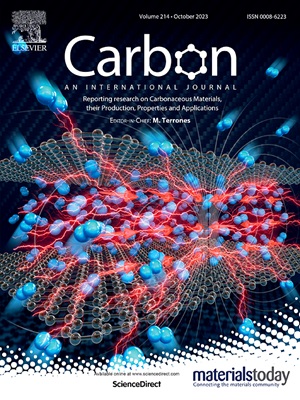D-π-A-structured two-dimensional mercury(II)-acetylide frameworks for near-infrared switchable nonlinear optics and ultrafast photonics
IF 10.5
2区 材料科学
Q1 CHEMISTRY, PHYSICAL
引用次数: 0
Abstract
Two-dimensional (2D) metal-acetylide frameworks (M-AFs), a novel class of 2D materials, demonstrate significant potential in optics and photonics due to their tunable optical and electrical properties, which is achieved through the incorporation of polarizability and spin-orbit coupling of single-metal centers into the graphdiyne (novel allotrope of carbon) frameworks via metal-bis(acetylide) linkages (−C≡C−M−C≡C−). Here, 2D mercury(II)-acetylide framework nanosheets (Hg–H2TPP) were prepared using liquid-phase exfoliation from their bulk counterparts. The incorporation of heavy HgII ions led to modifications in the electronic band structure, as evidenced by room-temperature photoluminescence and absorption spectra, indicating potential applications in the near-infrared (NIR) range. The nonlinear optical (NLO) properties of the 2D nanosheets were evaluated by measuring the nonlinear absorption coefficients (β). These coefficients ranged from −10.5 cm GW−1 (saturable absorption SA) to 10.9 cm GW−1 (reverse saturable absorption, RSA), demonstrating the nanosheets' potential as both saturable absorbers (SABs) and optical limiters. The observation that NIR-NLO properties were achieved only after the incorporation of HgII ions underscores the importance of material engineering in M-AF systems. To further assess the potential applications of this engineered material, Hg–H2TPP-based SABs were developed for NIR photonic devices. By utilizing these SABs, stable Q-switched and mode-locked lasers at 1560 nm were generated, yielding pulse widths (repetition rates) of 3.56 μs (38.33 kHz) and 779 fs (7.69 MHz), respectively. The identification of these novel photonic properties and applications indicates that 2D M-AFs possess significant potential for future ultrafast nonlinear optoelectronic devices.

求助全文
约1分钟内获得全文
求助全文
来源期刊

Carbon
工程技术-材料科学:综合
CiteScore
20.80
自引率
7.30%
发文量
0
审稿时长
23 days
期刊介绍:
The journal Carbon is an international multidisciplinary forum for communicating scientific advances in the field of carbon materials. It reports new findings related to the formation, structure, properties, behaviors, and technological applications of carbons. Carbons are a broad class of ordered or disordered solid phases composed primarily of elemental carbon, including but not limited to carbon black, carbon fibers and filaments, carbon nanotubes, diamond and diamond-like carbon, fullerenes, glassy carbon, graphite, graphene, graphene-oxide, porous carbons, pyrolytic carbon, and other sp2 and non-sp2 hybridized carbon systems. Carbon is the companion title to the open access journal Carbon Trends. Relevant application areas for carbon materials include biology and medicine, catalysis, electronic, optoelectronic, spintronic, high-frequency, and photonic devices, energy storage and conversion systems, environmental applications and water treatment, smart materials and systems, and structural and thermal applications.
 求助内容:
求助内容: 应助结果提醒方式:
应助结果提醒方式:


